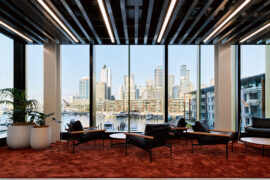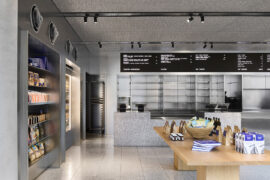Can A+D help clean up the 311,000,000 tonnes of rubbish contributed to our oceans each year? Well … it’s starting to look more achievable than ever!
In less than four years a 100-metre long island of rubbish will float between California and Hawaii … and we’ll put it there on purpose. As a veritable international rubbish tip for nations bordering the Pacific Ocean, the ‘Great Pacific Garbage Patch‘ doesn’t exactly sound like something we should be applauding – however it represents one of our greatest steps forward in approaching a more sustainable future, and certainly a more healthy sea. Funded by the Dutch Government and the incredible generosity of individuals across the world, the full-scale deployment of this initiative is geared solely toward ridding the Pacific Ocean of mounting waste deposits through a serpentine floating barrier made from vulcanised rubber that responds to the natural currents of sea. Anchored to the ocean floor and moving in conjunction with ocean currents, the structure contorts into shapes that allow both submerged and floating rubbish – from large individual pieces, to millimetre-wide debris – to funnel through into a centralised catchment area that can later be harvested and removed appropriately to recycling plants or facilities which manufacture renewable energy sources.
Prima facie, it sounds like a rather drastic project, but according to Sharon Dijksma – the Dutch Minister of the Environment – in a recent interview with The Guardian, the project represents a new way in which “we can use our political pressure with other governments, businesses and international institutions […] to combat ocean pollution on a global scale.” Standing as the largest (quite literally, at 100 metres long and 4,500 metres deep) ocean clean-up project in human history, this largely crowd-funded initiative has the impressive potential to capture and remove approximately half of the plastic, non-degradable and noxious materials that circle the north Pacific gyre – one of the several large systems of rotating ocean currents, and largest concentrations of ocean-borne pollution – within less than a decade. In conjunction with other systems strategically placed across the world’s oceans, a network of ‘Ocean Garbage Patches’ could within the space of a single generation turn back the clock on hundreds of years’ worth of our irresponsible and damaging impact: a rather staggering possibility considering the 311,000,000 tonnes of marine pollution and debris we’ve contributed per annum to the world’s oceans since 1964.
Though ‘The Great Pacific Garbage Patch’ is still on the horizon, a landmark test for the project is currently being deployed off the coast of Japan – a tremendously inspiring launch which is in no small part the due of a very charismatic 21-year old named Boyan Slat. In fact, in one of those stories that seem almost a little too Hollywood to be true, the ‘Great Pacific Garbage Patch’ is the brainchild of a curly-haired school dropout, who recently wowed international audiences at his sell-out Ted Talk earlier this year:
Now considered to be the world’s leading environmental entrepreneur, Boyan Slat and his Ocean Cleanup Project – of which The Great Pacific Garbage Patch is a core element – is beginning to inspire global political movements and corporate bodies to participate in what will be history’s first wholesale spring clean of our oceans. As the first credible and seemingly achievable project to tackle marine pollution, Slat’s visionary proposal has caught the attention of global brands keen to, in Slat’s own words, “finally do something!” And in this space, the A+D community in particular is demonstrating keen ingenuity. Everyday our industry proliferates even more environmental watchdogs, certification standards, sustainability awards and carbon-offsetting schemes to ensure that sustainability commitments are not the preserve solely of marketing departments – not solely, that is, mere green washing rhetoric – but concrete steps forward in combatting the sad fact that in less than 30 years there will categorically be more units of rubbish than per capita marine life in our oceans.
“Over the past decade, carpet manufacturers have allocated tremendous resources of money and manpower to improving sustainability within their individual companies, as well as the industry overall,” reveals Gibbon Group, specialists in commercial flooring solutions. “They’ve made great strides in reducing greenhouse gas emissions, water consumption and reliance on fossil fuels; in some cases substituting renewable energy sources. They’ve also increased the use of both post-industrial and post-consumer waste materials in carpet production (and) now sustainable manufacturing has become the norm.”
https://vimeo.com/214455979
It’s a brilliant standard for other industries to follow and a brand that deserves particular acclaim in this field is Modulyss. In 2008 the company became the first European manufacturer to bring an ecological carpet tile to the international market with a minimum of 70% recycled material (using Econyl 70 by Aquafil). A year later it set up the CARE program, in which carpet tiles get used as fuel, and in 2011 all of its eco-collections started using Aquafil’s Econyl yarns – the regenerated material which increased from 70% to 100% waste content.
Modulyss’ most recent contribution to our environment though came in 2015 when it formed a partnership with Healthy Seas, set up by the Aquafil Group, Star Sock and The ECNC Group to combat the issue of marine waste. According to a report from the Food and Agriculture Organisation of the UN and the United Nations Environment Programme, an eye-boggling 640,000 tonnes of discarded fishing gear is left in our oceans every year and discarded nets can remain in the sea for centuries catching or injuring our marine life!
By bringing together a number of different stakeholders including divers, fisheries, NGOs, governments and communities, as well as salvage, recycling and production companies, Healthy Seas takes action by the following: Raising public awareness, helping prevent marine littering, diving for abandoned fishnets and collaborating with fishermen and harbours in order to collect their used fishnets into dedicated areas within the harbours. The organisation has also has started recovering nets from the North, Adriatic and Mediterranean Seas as these areas are heavily fished and hold many shipwrecks where waste fishing nets seem to accumulate.
Fishing nets can be made of many different materials but ‘nylon 6’ is the only one used in fishing net production that can be recycled and regenerated. As such, Healthy Seas encourages fish farmers only to use nets made from this material and, as Modulyss also uses nylon 6 to manufacture its carpet tiles, it made perfect sense for the brand to join Healthy Seas as an associate partner member.
Aquafil is the leading manufacturer of nylon 6 and its future goal is to manufacture products that are not only entirely made of regenerated material, but are fully and endlessly regenerable. However, its Econyl Regeneration System is already the world’s most efficient industrial system for the production on nylon 6 from 100% regenerated waste materials. Thus, by using Econyl yarns for its carpets ‘face fibres’ as well as 100% post-consumer recycled polyester for its primary backing, Modulyss takes sustainability to a whole new level. It even uses its own carpet tile waste in the carpets’ secondary backing, giving the backing a 10% post-industrial recycled content.
The brand’s commitment to sustainability is truly exemplary and in 2016 the energy it saved by using Econyl yarn in its eco-collections was the equivalent of 2.243 households energy usage for a year. This equates to 1.971.809kg of reduced CO2 equivalent emissions. Or put another way – the amount of emissions used by a car circumnavigating the equator more than 490 times!
Most of us might not be able to imagine quite how long that trip is, or the time it would take, but one thing’s for sure – it’s an enormous saving in energy! Other industries would do well to take note and learn from a market that’s quite literally paved the way in eco-friendly manufacturing.
INDESIGN is on instagram
Follow @indesignlive
A searchable and comprehensive guide for specifying leading products and their suppliers
Keep up to date with the latest and greatest from our industry BFF's!

For Aidan Mawhinney, the secret ingredient to Living Edge’s success “comes down to people, product and place.” As the brand celebrates a significant 25-year milestone, it’s that commitment to authentic, sustainable design – and the people behind it all – that continues to anchor its legacy.

London-based design duo Raw Edges have joined forces with Established & Sons and Tongue & Groove to introduce Wall to Wall – a hand-stained, “living collection” that transforms parquet flooring into a canvas of colour, pattern, and possibility.

Warren and Mahoney’s design for Beca’s Auckland headquarters turns the mechanics of engineering into poetry, rethinking how workplace design can reveal its own systems.

IF Architecture crafts Baker Bleu Cremorne into a refined, sustainable bakery and café where industrial design meets artisanal warmth.
The internet never sleeps! Here's the stuff you might have missed

‘The Mandate Mirage: 2025 Workplace Futures Survey’ is a new report by international design practice Hassell, revealing that the real drawcard for attracting employees to the office in-person is choice.

COX Architecture and Yerrabingin reveal the design for Canberra Lyric Theatre — a world-class, inclusive venue for the nation’s capital.